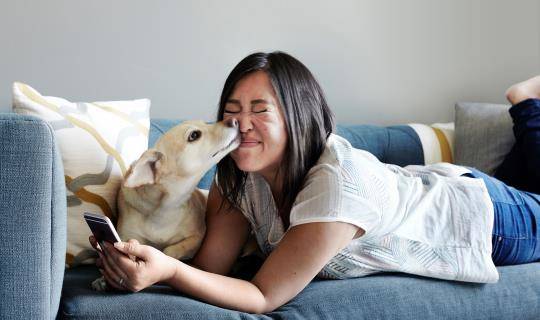Roundtable: How has technology helped your veterinary practice
By MWI Animal Health
MWI customers embrace innovation for clinic efficiency and pet owner engagement and satisfaction

Over the past 20 years, technology has changed businesses and lives in incredible ways. In just the past five years, there's been a significant acceleration of technology affecting our everyday lives. Veterinary practices have transformed from communicating via paper reminders to connecting with clients on apps. Staff send orders they previously faxed to labs via digital interfaces. Within veterinary practices, this evolution is changing the experience of the veterinarian and the practice staff. The experience of the pet owner and how they interact with the practice is becoming digital first.
Jonathan Holloway, Senior Director of Product and Technology for MWI Animal Health, talked to three customers about how technology has changed their practice workflows, communication strategies, and client relationships. We discussed challenges that come with adopting new technologies and how to reframe them as future opportunities that technology can help.
James Harris, MA, VetMB, CertSAM, MRCVS, is group clinical director at a growing chain of independent practices called Harrison Family Vets. He has a passion for using technology to make veterinarians' lives as enjoyable as possible.
Norrie Graham, MRCVS, is owner of Rase Vets, a large independent practice covering Lincolnshire and South Yorkshire. She’s an equine vet by trade with a strong interest in promoting independent practices and making life as easy and enjoyable as possible for the vets they employ.
Rebecca Smith is administration manager at an independent practice called Ryder-Davies & Partners in Suffolk. Technology in the reception area of the practice is very important to her role here.
Q: What has been the key technology change in your business over the last year? How has it benefited your business?
Norrie: The biggest technology difference this year is a new insurance product, based on our PMS data. This data and the use of analytics allows us to provide tailored clinical pathways to help our customers. The insurance company, in turn, gets a realistic idea of what things actually cost. Invoices are 100 percent guaranteed payout, assuming they got through the original approval process for coverage. It's a new innovative idea with pet insurance, and I think it's the way forward.James: For us, it's using mobile app technology to improve the way we communicate with clients. About 50 people join our app every day, and we manage over 400 chats every day in the practice. We're communicating with our clients at every step of the process, using the app. Communicating while pets are in practice, during the consultation period, and communicating after they have left the practice. This helps us to be as efficient as possible. We’re not just hitting people with more communication, but we're making the communication much more focused and relevant to clients.
We linked the app technology with our practice management system (PMS/PIMS), so entering a code triggers the right communication process. Practice team members don’t have to search for leaflets or think of what to say, creating an efficient process. The pet owner has the ability to continue the chat, making it a personalised experience. We're literally just touching the surface of all the possibilities here.
Rebecca: A big recent change for us is automating all our reminders through the practice management system. We also use a communication service that reduces the number of phone calls into practice. Pet owners can book appointments, order medications, message us. We send pictures of their pets while they’re with us ... It takes pressure off the reception staff when they don’t have multiple phone lines ringing at once.
Q: What have been the challenges of adopting new technologies?
Norrie: One of the challenges is with different vendors being able to talk to each other, communicate, and agree. Having open standards is crucial, rather than having walled gardens where you can't share data and you can't access integrated solutions.James: In terms of efficiency, the biggest challenge is incoming phone calls. By using app-based technology that provides clients the opportunity to contact us whenever they want, using asynchronous communication, we see a significant reduction in calls. It's asynchronous; this is the important bit. They ask a question, but they don't get to reply on their time. They get to reply on our time. That’s incredibly important to set the clients’ expectations. When we started, we didn't do that, and it led to some complaints. A very early lesson is that you have to be absolutely black and white about how the communication is going to happen.
Now, if the phone is ringing, the probability is much higher, it really does need to be answered in three to five rings. It’s more likely this pet is sick and needs to be seen and less likely it’s a client ordering medicine.
Norrie: What we’re aiming to do with negative situations is to strive for them not to happen in the first place. Human contact in difficult situations is irreplaceable. The phone call after you've had a complaint come in will often defuse the situation.
I don't think technology should be used for dealing with complaints particularly, but I think technology is useful for making sure we're communicating as often as possible so they're less likely to lead to a complaint. Complaints happen because of mistakes, and let's be honest, some mistakes happen because our current technology lets us down because it's not integrated. That's an area which could be improved.
Q: How has the use of mobile technology influenced how you work as a veterinary business?
James: We're starting to use some clever technology with Butterfly handheld ultrasound machines, which integrates well into the practice management system. It makes it a lot easier to send images to clients. And I think it's something we're going to see a lot more of.
Rebecca: We have equine vets that go out and will use the tablets so they can access the cloud-based practice management system. In practice, having a system accessible on a tablet allows the nurses to answer client queries [and] process invoices on the go, rather than sitting at a physical desktop computer.
Q: What are the key areas where you see opportunities for technology helping you in-practice?
James: The biggest place we can move forward is integration. Ultrasound, in-house lab, reference lab, everything coming into one place because it makes life easy and it's more reliable. Data is segregated for the most part and where it does work together, it's clunky and breaks frequently. The more integrated, the better as far as I'm concerned.
Norrie: There is a valid opportunity [for integration] in our laboratory side. We've invested in some equipment where techs put a fluid sample on this microscope, and it is beamed around the world to a pathologist, and you get a written report within hours. This will be huge for turnaround speed but also financial savings. Historically, you’re wasting days waiting for mailed paper results.
James: Your example of that microscope, that's where technology is available now. I came in, scanned a dog, took some samples, put the samples in, and they went off to be read. I got the cytology report before discharge, and we started chemotherapy that very same day. The use of technology is improving what we do. It's exciting times.
Rebecca: On the reception side of things, integration is about reducing the paper consent forms, having them automated online. At the moment, they're printed from the practice management system, they're signed, they're sometimes re-uploaded onto the database. I really see further integration and improvement with tablet-based in-house pet owner communications as well. It reduces the filing and extra workload for reception.
The concept of a paperless veterinary practice, I think, is possible. It’s getting people into the mindset and making them confident in using the systems, that they work well enough.
Q: Where do you see the future of technology going in the modern veterinary practice?
Norrie: We've started with technology that monitors heart rate, respiratory rate, and temperature. All those recordings go onto an iPad. If that information could go straight onto the file as well, it would improve accuracy.
James: The advent of ChatGPT has obviously been big, and Open AI has been the big change within the last year. Plug that into clinical notes, plug that into all the data and the information we have. There's a massive opportunity there, I feel, for improving that experience.
A lot of the answers to questions we get asked are repeatable, so that would be an area where incoming chat conversations could be managed through AI technology. I think that vets spend an awful lot of time writing clinical notes, and it can be quite dull. What I would love is for the note-taking to be verbal and use AI to make it a conversation. For instance, the AI recognizes the vet hasn't recorded the weight or the body condition score and triggers the request for the information. I've not seen anything doing this. If you do know, please tell me because I'm looking for it.
From our panelists’ experience, it’s clear that practice technology will only keep changing. The question remains: Will professionals continue to evolve alongside it? As these customers showed, the curiosity and confidence to embrace it will take them far.
We just scratched the surface here in terms of technology and will delve into each of the areas discussed here in forthcoming articles and webinars with our MWI Practice Technology consultancy team.





